Energy Saving Potential of a Thermoelectric Heat Pump-Assisted Liquid Desiccant System in a Dedicated Outdoor Air System
Abstract
:1. Introduction
2. System Overview
2.1. A THP-Assisted Liquid Desiccant (THPLD) System
2.2. THPLD-Based Dedicated Outdoor Air System (DOAS)
3. Research Methodology
3.1. Building Information
3.2. System Simulation Overview
3.3. Liquid Desiccant Unit
3.4. Standard THP Model
3.5. Membrane Enthalpy Exchanger
3.6. Chiller Model
3.7. Ceiling Radiant Cooling Panel Model
3.8. Fan and Pump
4. Results
4.1. Design of the THP for the LD System
4.2. CRCP Design of System Cases
4.3. Operating Energy Consumption in the Cooling Season
5. Conclusions
Acknowledgments
Author Contributions
Conflicts of Interest
Nomenclature
| Apex angle (°) | |
| Seebeck coefficient (V/K) | |
| Specific heat (kj/kg·°C) | |
| Diffusivity of water vapor in air (m2/s) | |
| Hydraulic diameter (m) | |
| Room position index | |
| Height (m) | |
| Enthalpy (kj/kg) | |
| Heat transfer coefficient (W/m2·°C) | |
| Mass transfer coefficient (W/m2·°C) | |
| Electric current (A) | |
| Thermal conductance (W/K) | |
| Conduction heat transfer coefficient of air (W/m·K) | |
| Panel thermal conductivity (W/m·°C) | |
| Leg length (m) | |
| Mass flow rate (kg/s) | |
| Nusselt number | |
| NTU | Number of transfer units |
| Density (kg/m3) | |
| Electrical resistivity of the TEM (·m) | |
| Power (W) | |
| Heat flux (kw) | |
| Electrical resistance () | |
| Thermal contact resistance (K/W) | |
| Leg section area (m2) | |
| Temperature (°C) | |
| Diffuser discharge velocity (m/s) | |
| Diffuser width (m) | |
| Humidity ratio (kg/kg) | |
| Concentration | |
| Height of the control volume (m) | |
| Thermal conductivity of the TEM (W/m·K) | |
| Effectiveness (%) | |
| Tube spacing (m) | |
| Ratio of the total number of transfer units for moisture to that for sensible heat | |
| Panel thickness (m) |
Abbreviations
| AC | Air conditioning |
| CAPFT | Cooling capacity function of the temperature curve |
| COP | Coefficient of performance |
| CRCP | Ceiling radiant cooling panel |
| DOAS | Dedicated outdoor air system |
| DPT | Dew point temperature |
| EES | Engineering equation solver |
| EIRFT | Energy input to the cooling output ratio function of the temperature curve |
| EIRFPLR | Energy input to the cooling output ratio function of the part load ratio curve |
| HVAC | Heating ventilating and air conditioning |
| LD | Liquid desiccant |
| MEE | Membrane enthalpy exchanger |
| OA | Outdoor air |
| PLR | Part load ratio |
| RSHF | Room sensible heat factor |
| SA | Supply air |
| TEM | Thermoelectric module |
| THP | Thermoelectric heat pump |
| TRNSYS | Transient systems simulation |
Greek Symbols
| Subscripts | |
| Air | |
| Absorber | |
| Cold side | |
| Chilled water | |
| Chiller | |
| Condenser | |
| Entering | |
| Hot side | |
| Leaving | |
| Latent | |
| max | Maximum |
| min | Minimum |
| Plate | |
| Primary | |
| Return air | |
| Regenerator | |
| Reference | |
| Solution | |
| Saturation | |
| Secondary | |
| Sensible | |
| Vapor | |
| Water | |
References
- Jeong, J.W.; Mumma, S. Energy conservation benefits of a dedicated outdoor air system with parallel sensible cooling by ceiling radiant panels. ASHRAE Trans. 2003, 109, 627–636. [Google Scholar]
- Deng, S.; Lau, J.; Jeong, J.W. Do all DOAS configurations provide the same benefits? ASHRAE J. 2014, 56, 52–57. [Google Scholar]
- Zhang, L.; Zhang, Y.F. Research on energy saving potential for dedicated ventilation systems based on heat recovery technology. Energies 2014, 7, 4261–4280. [Google Scholar] [CrossRef]
- Zhang, L.; Zhang, Y.F. Research on heat recovery technology for reducing the energy consumption of dedicated ventilation systems: An application to the operating model of a laboratory. Energies 2016, 9, 24. [Google Scholar] [CrossRef]
- Kawamoto, K.; Cho, W.; Kohno, H.; Koganei, M.; Ooka, R.; Kato, S. Field study on humidification performance of a desiccant air-conditioning system combined with a heat pump. Energies 2016, 9, 89. [Google Scholar] [CrossRef]
- Coad, W.J. Conditioning ventilation air for improved performance and air quality. HPAC Eng. 1999, 71, 49–56. [Google Scholar]
- Khattar, M.K.; Brandemuehl, M.J. Separating the V in HVAC: A dual-path approach. ASHRAE J. 2002, 44, 37–42. [Google Scholar]
- Ge, G.; Xiao, F.; Wang, S. Optimization of a liquid desiccant based dedicated outdoor air-chilled ceiling system serving multi-zone spaces. Build. Simul. 2012, 5, 257–266. [Google Scholar] [CrossRef]
- Liu, X.; Li, Z.; Jiang, Y.; Lin, B. Annual performance of liquid desiccant based independent humidity control HVAC system. Appl. Therm. Eng. 2006, 26, 1198–1207. [Google Scholar] [CrossRef]
- Xiao, F.; Ge, G.; Niu, X. Control performance of a dedicated outdoor air system adopting liquid desiccant dehumidification. Appl. Energy 2011, 88, 143–149. [Google Scholar] [CrossRef]
- Ge, G.; Xiao, F.; Xu, X. Model-based optimal control of a dedicated outdoor air-chilled ceiling system using liquid desiccant and membrane-based total heat recovery. Appl. Energy 2011, 88, 4180–4190. [Google Scholar] [CrossRef]
- Goetzler, W.; Zogg, R.; Young, J.; Johnson, C. Energy Savings Potential and RD&D Opportunities for Non-Vapor-Compression HVAC Technologies; Navigant Consulting Inc.; US Department of Energy: Washington, DC, USA, 2014.
- Kim, M.H.; Park, J.S.; Jeong, J.W. Energy saving potential of liquid desiccant in evaporative-cooling-assisted 100% outdoor air system. Energy 2013, 59, 726–736. [Google Scholar] [CrossRef]
- Crofoot, L.; Harrison, S. Performance evaluation of a liquid desiccant solar air conditioning system. Energy Procedia 2012, 30, 542–550. [Google Scholar] [CrossRef]
- Abdel-Salam, A.H.; Ge, G.; Simonson, C.J. Thermoeconomic performance of a solar membrane liquid desiccant air conditioning system. Sol. Energy 2014, 102, 56–73. [Google Scholar] [CrossRef]
- Niu, X.; Xiao, F.; Ma, Z. Investigation on capacity matching in liquid desiccant and heat pump hybrid air-conditioning systems. Int. J. Refrig. 2012, 35, 160–170. [Google Scholar] [CrossRef]
- Zhang, L.-Z.; Zhang, N. A heat pump driven and hollow fiber membrane-based liquid desiccant air dehumidification system: Modelling and experimental validation. Energy 2014, 65, 441–451. [Google Scholar] [CrossRef]
- Bergero, S.; Chiari, A. On the performances of a hybrid air conditioning system in different climatic conditions. Energy 2011, 36, 5261–5273. [Google Scholar] [CrossRef]
- Liu, Z.; Zhang, L.; Gong, G.; Li, H.; Tang, G. Review of solar thermoelectric cooling technologies for use in zero energy buildings. Energy Build. 2015, 102, 207–216. [Google Scholar] [CrossRef]
- Chen, L.; Li, J.; Sun, F.; Wu, C. Performance optimization for a two-stage thermoelectric heat-pump with internal and external irreversibilities. Appl. Energy 2008, 85, 641–649. [Google Scholar] [CrossRef]
- Riffat, S.B.; Ma, X.; Wilson, R. Performance simulation and experimental testing of a novel thermoelectric heat pump system. Appl. Therm. Eng. 2006, 26, 494–501. [Google Scholar] [CrossRef]
- Lai, H.; Pan, Y.; Chen, J. Optimum design on the performance parameters of a two-stage combined semiconductor thermoelectric heat pump. Semicond. Sci. Technol. 2003, 19, 17. [Google Scholar] [CrossRef]
- Khire, R.A.; Messac, A.; Van Dessel, S. Design of thermoelectric heat pump unit for active building envelope systems. Int. J. Heat Mass Transf. 2005, 48, 4028–4040. [Google Scholar] [CrossRef]
- Kim, Y.W.; Ramousse, J.; Fraisse, G.; Dalicieux, P.; Baranek, P. Optimal sizing of a thermoelectric heat pump (THP) for heating energy-efficient buildings. Energy Build. 2014, 70, 106–116. [Google Scholar] [CrossRef]
- Han, T.; Gong, G.; Liu, Z.; Zhang, L. Optimum design and experimental study of a thermoelectric ventilator. Appl. Therm. Eng. 2014, 67, 529–539. [Google Scholar] [CrossRef]
- Yadav, Y.K. Vapour-compression and liquid-desiccant hybrid solar space-conditioning system for energy conservation. Renew. Energy 1995, 6, 719–723. [Google Scholar] [CrossRef]
- Kinsara, A.A.; Elsayed, M.M.; Al-Rabghi, O.M. Proposed energy-efficient air-conditioning system using liquid desiccant. Appl. Therm. Eng. 1996, 16, 791–806. [Google Scholar] [CrossRef]
- Kinsara, A.A.; Al-Rabghi, O.M.; Elsayed, M.M. Parametric study of an energy efficient air conditioning system using liquid desiccant. Appl. Therm. Eng. 1998, 18, 327–335. [Google Scholar] [CrossRef]
- Ahmed, C.K.; Gandhidasan, P.; Al-Farayedhi, A.A. Simulation of a hybrid liquid desiccant based air-conditioning system. Appl. Therm. Eng. 1997, 17, 125–134. [Google Scholar] [CrossRef]
- Dai, Y.J.; Wang, R.Z.; Zhang, H.F.; Yu, J.D. Use of liquid desiccant cooling to improve the performance of vapor compression air conditioning. Appl. Therm. Eng. 2001, 21, 1185–1202. [Google Scholar] [CrossRef]
- Ani, F.N.; Badawi, E.M.; Kannan, K.S. The effect of absorber packing height on the performance of a hybrid liquid desiccant system. Renew. Energy 2005, 30, 2247–2256. [Google Scholar] [CrossRef] [Green Version]
- Ma, Q.; Wang, R.Z.; Dai, Y.J.; Zhai, X.Q. Performance analysis on a hybrid air-conditioning system of a green building. Energy Build. 2006, 38, 447–453. [Google Scholar] [CrossRef]
- Zhang, L.; Dang, C.; Hihara, E. Performance analysis of a no-frost hybrid air conditioning system with integrated liquid desiccant dehumidification. Int. J. Refrig. 2010, 33, 116–124. [Google Scholar] [CrossRef]
- Bergero, S.; Chiari, A. Performance analysis of a liquid desiccant and membrane contactor hybrid air-conditioning system. Energy Build. 2010, 42, 1976–1986. [Google Scholar] [CrossRef]
- Secretariat, O. The Montreal Protocol on Substances that Deplete the Ozone Layer; United Nations Environment Program: Nairobi, Kenya, 2000. [Google Scholar]
- Creazzo, J.A.; Hammel, H.S.; Cicalo, K.J.; Schindler, P. Zero-ODP blowing agents for polyurethane foams. J. Cell. Plast. 1995, 31, 154–176. [Google Scholar] [CrossRef]
- Luo, Y.; Zhang, L.; Liu, Z.; Wang, Y.; Meng, F.; Xie, L. Modeling of the surface temperature field of a thermoelectric radiant ceiling panel system. Appl. Energy 2016, 162, 675–686. [Google Scholar] [CrossRef]
- Liu, Z.B.; Zhang, L.; Gong, G.C.; Han, T.H. Experimental evaluation of an active solar thermoelectric radiant wall system. Energy Convers. Manag. 2015, 94, 253–260. [Google Scholar] [CrossRef]
- Jeong, J.W.; Choi, A.; No, S.T. Improvement in demand-controlled ventilation simulation on multi-purposed facilities under an occupant based ventilation standard. Simul. Model. Pract. Theory 2010, 18, 51–62. [Google Scholar] [CrossRef]
- Holder, H.W. DOAS & humidity control. ARSHFAE J. 2008, 50, 34. [Google Scholar]
- Klein, S.A.; Beckman, W.A.; Mitchell, J.W.; Duffie, J.A. TRNSYS 17—A Transient System Simulation Program; User Manual; Solar Energy Laboratory, University of Wisconsin-Madison: Madison, WI, USA, 2009. [Google Scholar]
- Klein, S.A.; Alvarado, F.L. EES: Engineering Equation Solver for the Microsoft Windows Operating System; F-Chart Software: Madison, WI, USA, 1992. [Google Scholar]
- Li, C.L.; Chung, S.L. Enthalpy-based automatic temperature control for automobiles. In Proceedings of the 2009 IEEE Control Applications, (CCA) & Intelligent Control, (ISIC), St. Petersburg, Russia, 8–10 July 2009; pp. 222–227. [Google Scholar]
- Yin, Y.; Zhang, X.; Peng, D.; Li, X. Model validation and case study on internally cooled/heated dehumidifier/regenerator of liquid desiccant systems. Int. J. Therm. Sci. 2009, 48, 1664–1671. [Google Scholar] [CrossRef]
- Luo, Y.; Yang, H.; Lu, L.; Qi, R. A review of the mathematical models for predicting the heat and mass transfer process in the liquid desiccant dehumidifier. Renew. Sustain. Energy Rev. 2014, 31, 587–599. [Google Scholar] [CrossRef]
- Liu, J.; Liu, X.; Zhang, T. Performance comparison of three typical types of internally-cooled liquid desiccant dehumidifiers. Build. Environ. 2016, 103, 134–145. [Google Scholar] [CrossRef]
- Ramousse, J.; Sgorlon, D.; Fraisse, G.; Perier-Muzet, M. Analytical optimal design of thermoelectric heat pumps. Appl. Therm. Eng. 2015, 82, 48–56. [Google Scholar] [CrossRef]
- Product Sheet. Available online: http://www.aksteel.com/pdf/markets_products/stainless/martensitic/420_data_sheet.pdf (accessed on 30 August 2017).
- Zhang, L.Z.; Niu, J.L. Effectiveness correlations for heat and moisture transfer processes in an enthalpy exchanger with membrane cores. J. Heat Transf. 2002, 124, 922–929. [Google Scholar] [CrossRef]
- RenewAire, RenewAire LLC. Available online: http://www.renewaire.com/ (accessed on 31 August 2017).
- U.S. Department of Energy. Building Technologies Program; U.S. Department of Energy: Washington, DC, USA, 2013.
- Hydeman, M.; Webb, N.; Sreedharan, P.; Blanc, S. Development and testing of a reformulated regression-based electric chiller model/Discussion. ARSHFAE Trans. 2002, 108, 1118. [Google Scholar]
- Jeong, J.W.; Mumma, S.A. Practical cooling capacity estimation model for a suspended metal ceiling radiant cooling panel. Build. Environ. 2007, 42, 3176–3185. [Google Scholar] [CrossRef]
- HVAC Fundamentals; ASHRAE Handbook; American Society of Heating, Refrigerating and Air-Conditioning Engineers, Inc.: Atlanta, GA, USA, 2017.
- Lowenstein, A.; Slayzak, S.; Kozubal, E. A zero carryover liquid-desiccant air conditioner for solar applications. In Proceedings of the International Solar Energy Conference, Denver, CO, USA, 8–13 July 2006. [Google Scholar]
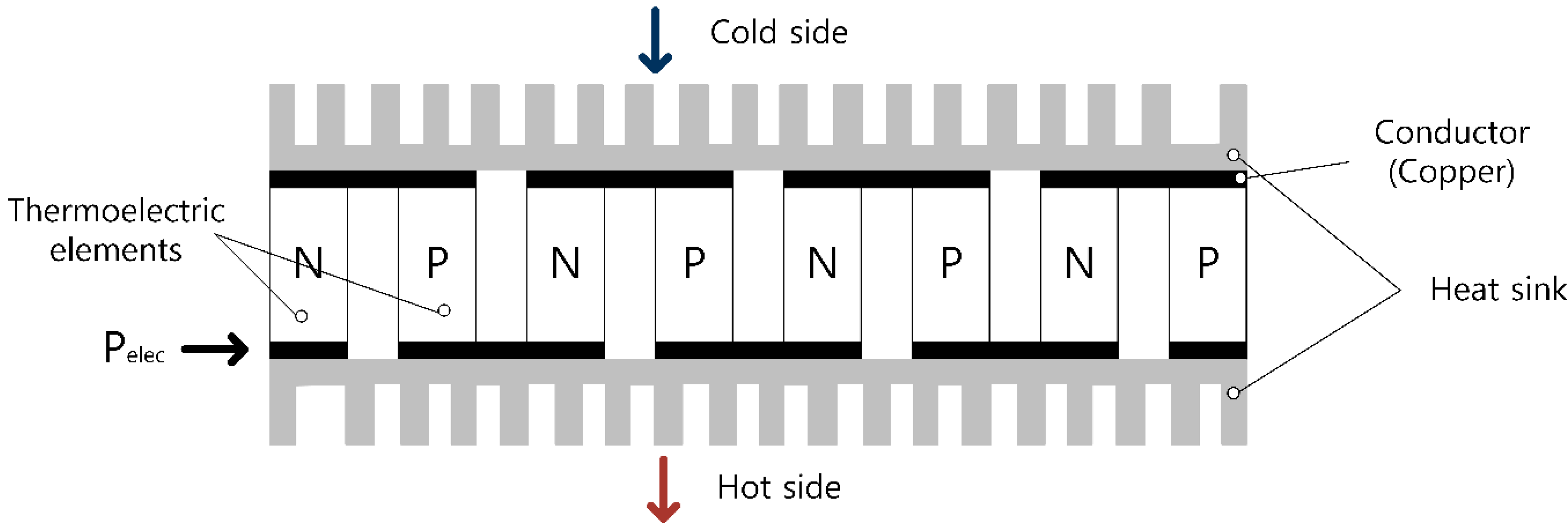
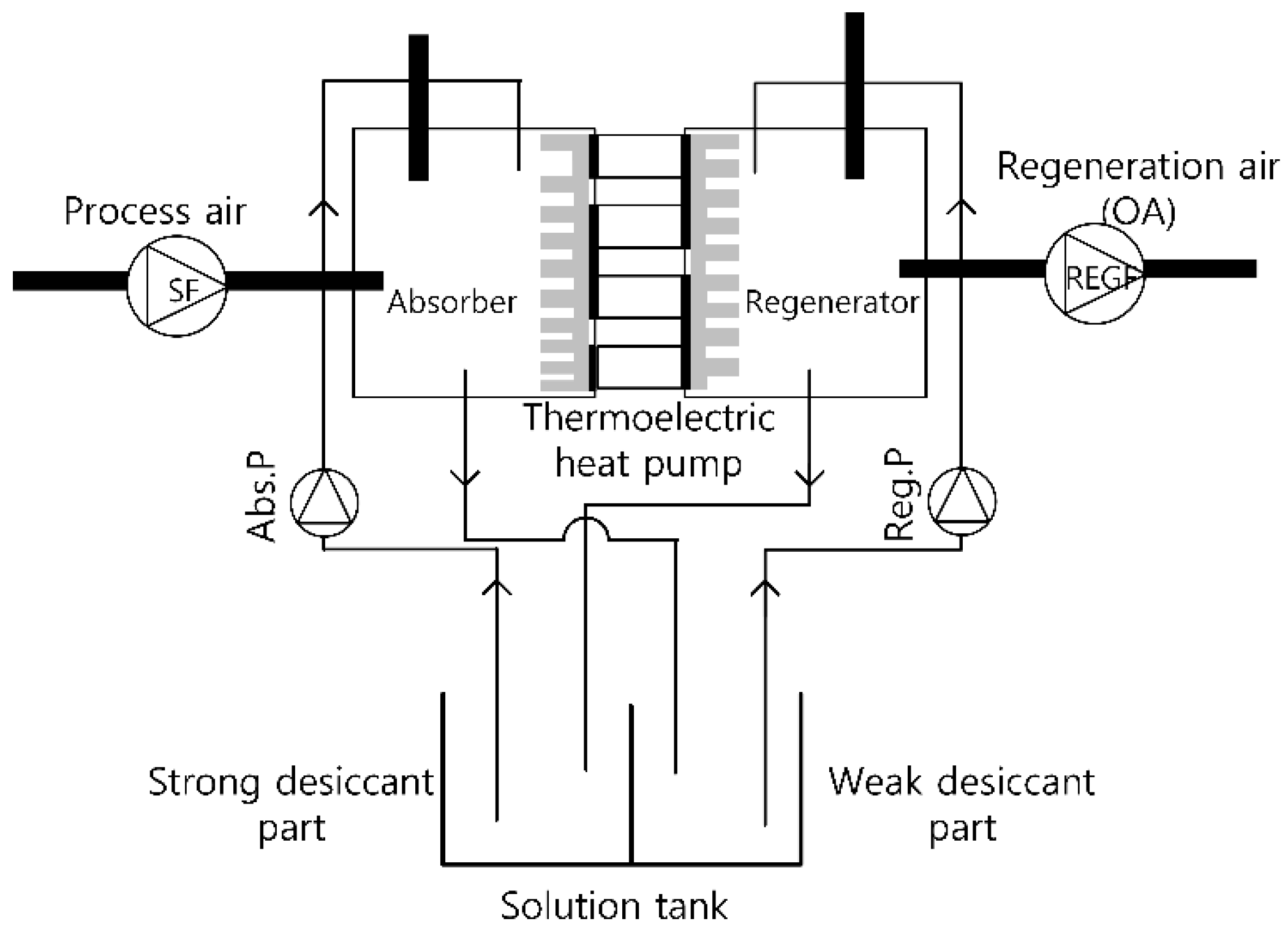
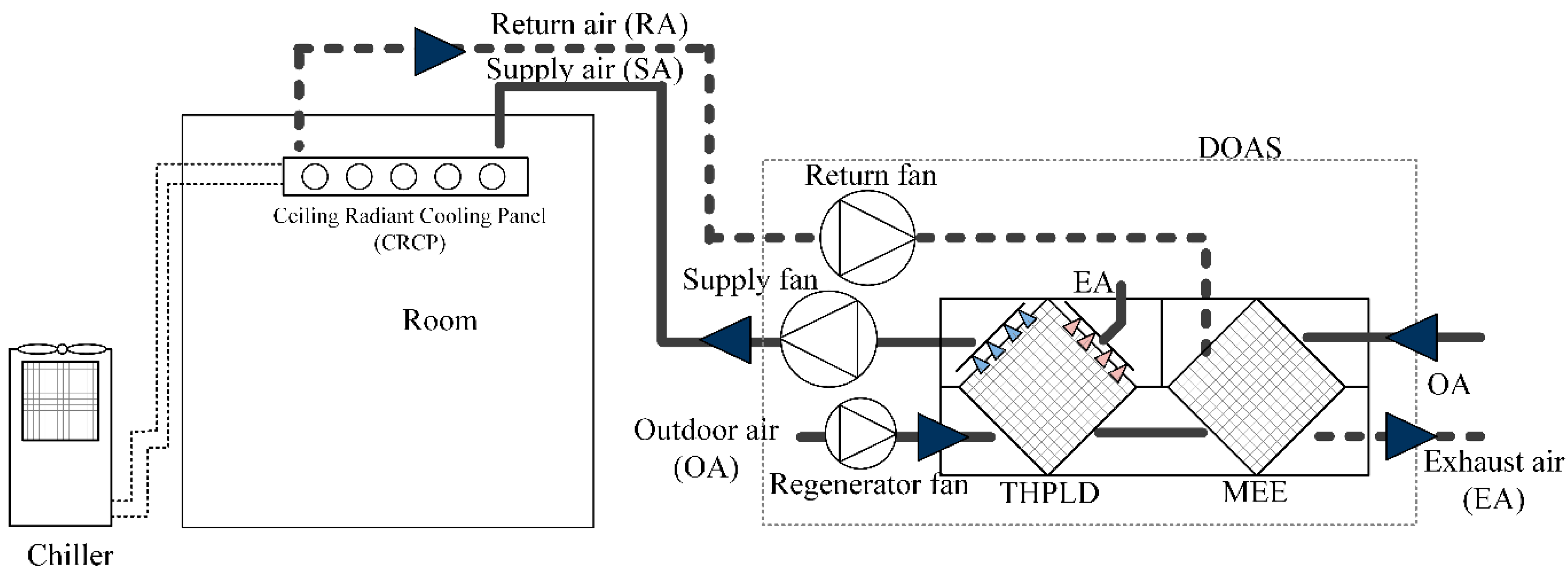

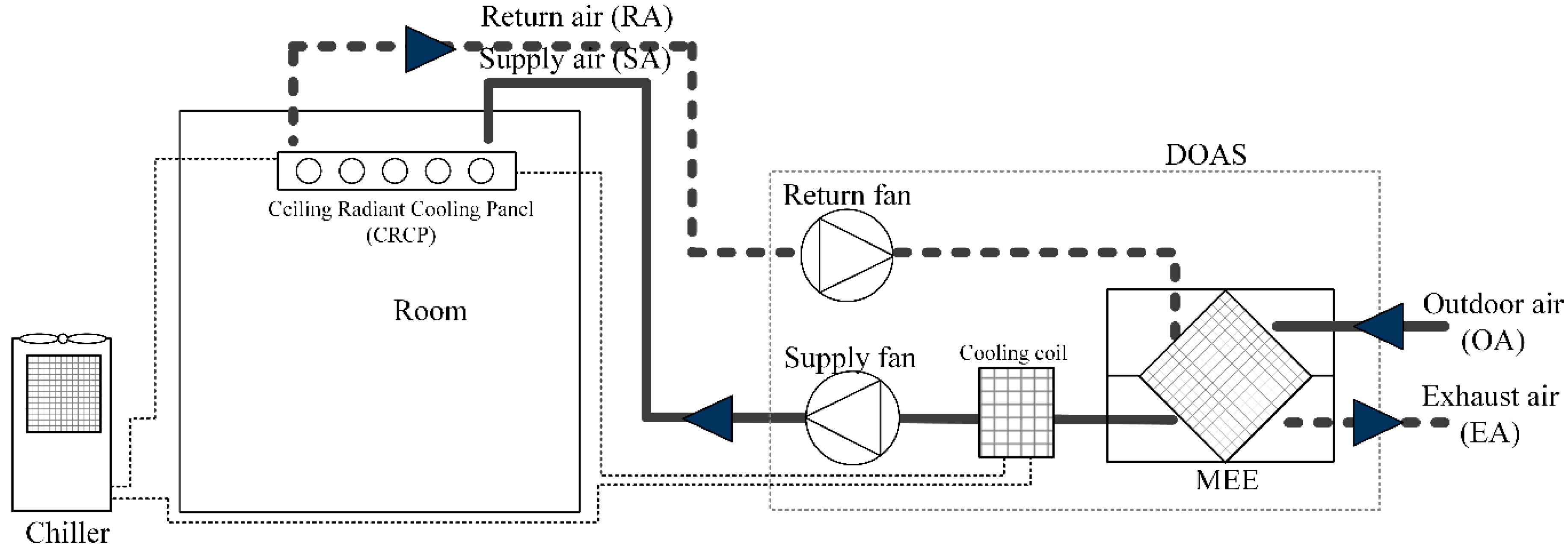
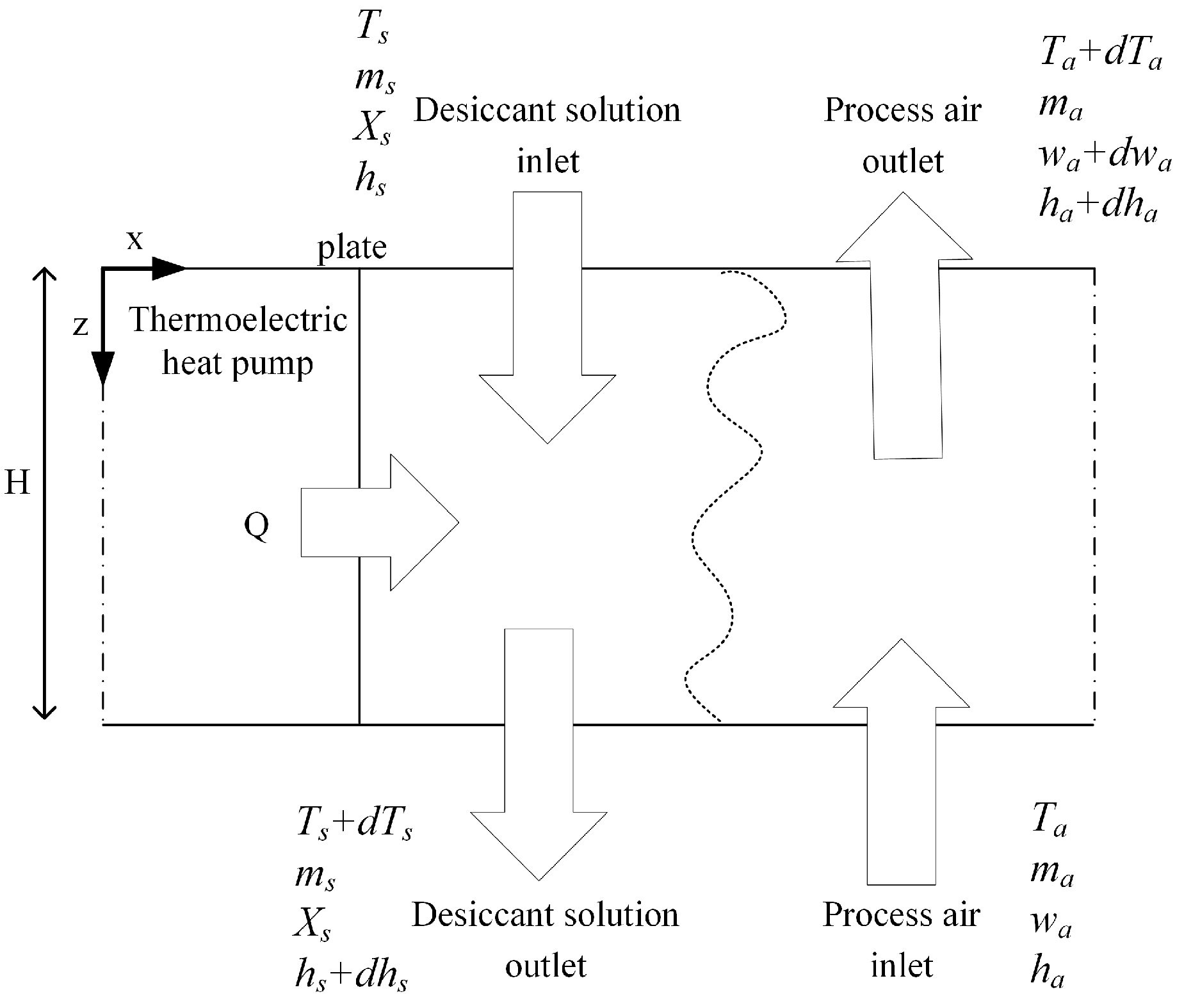
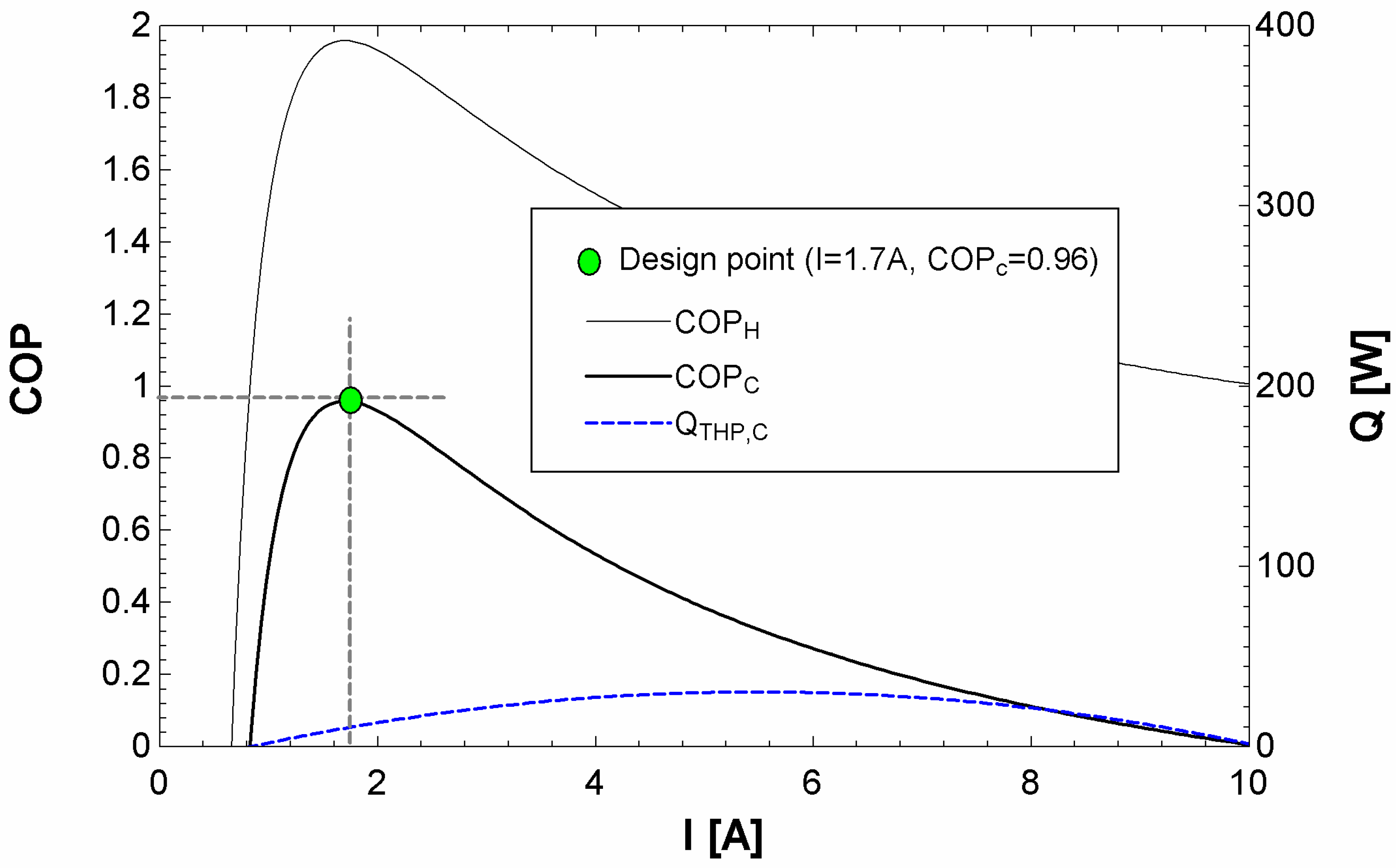
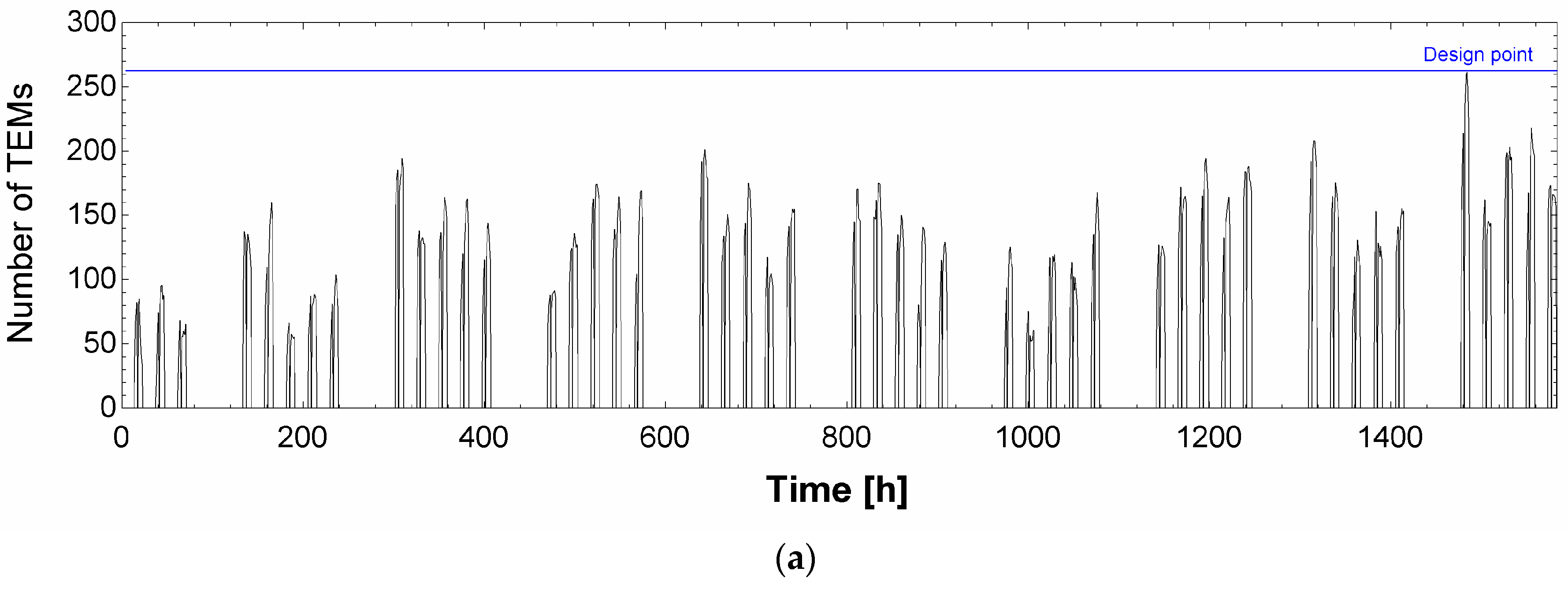
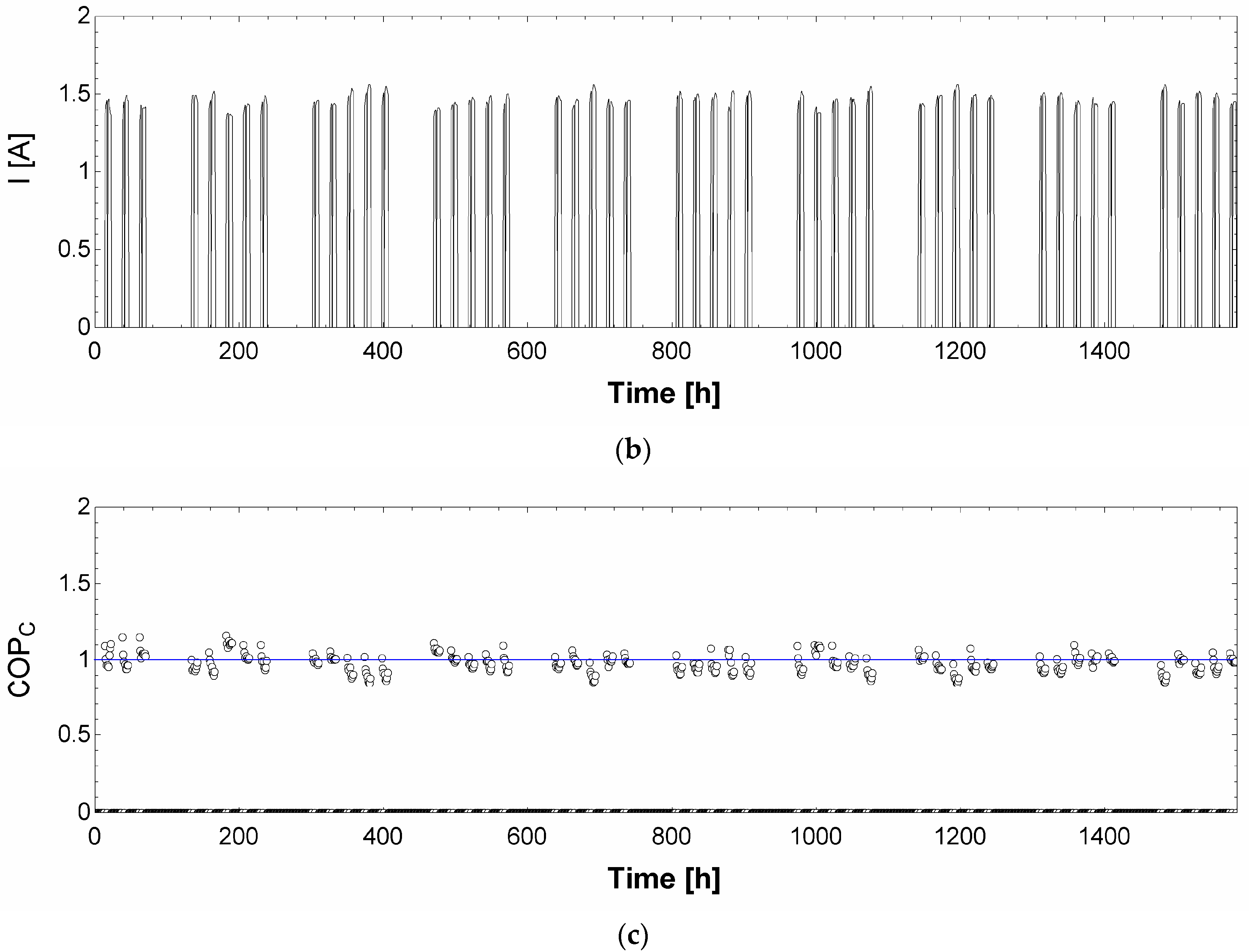
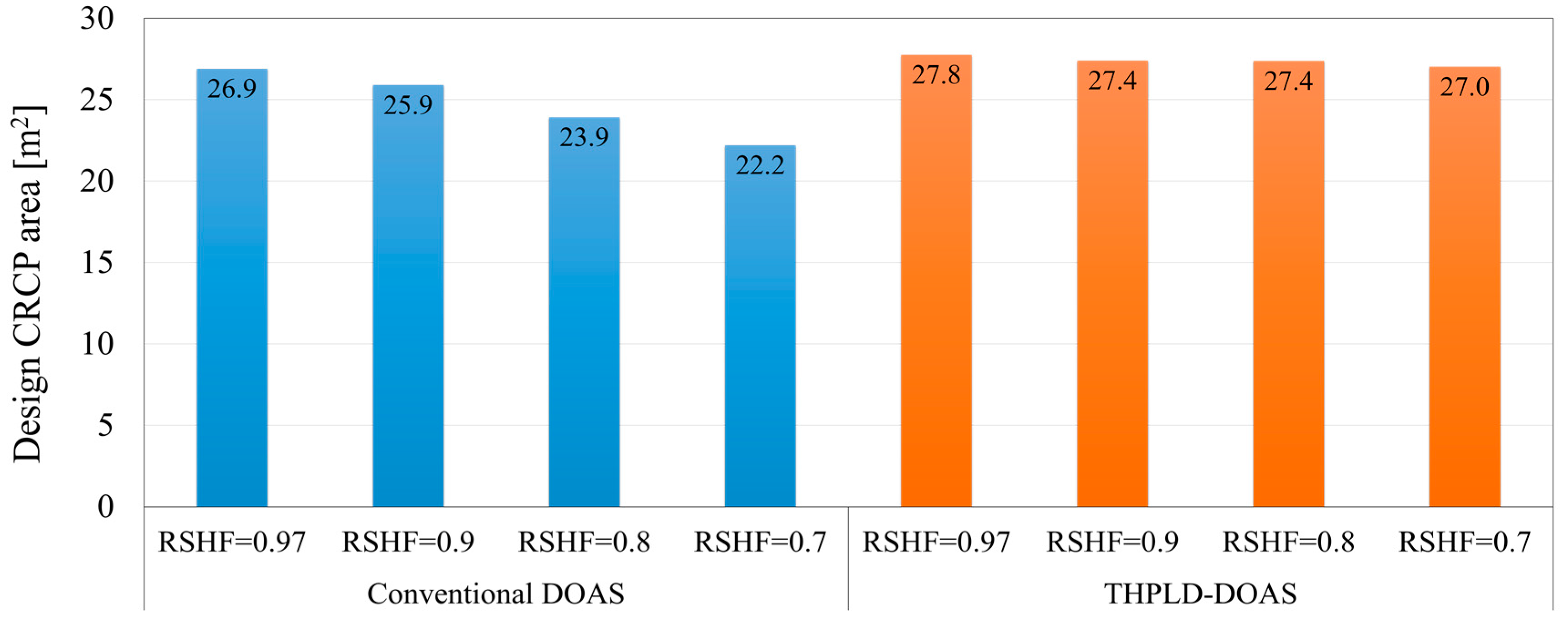
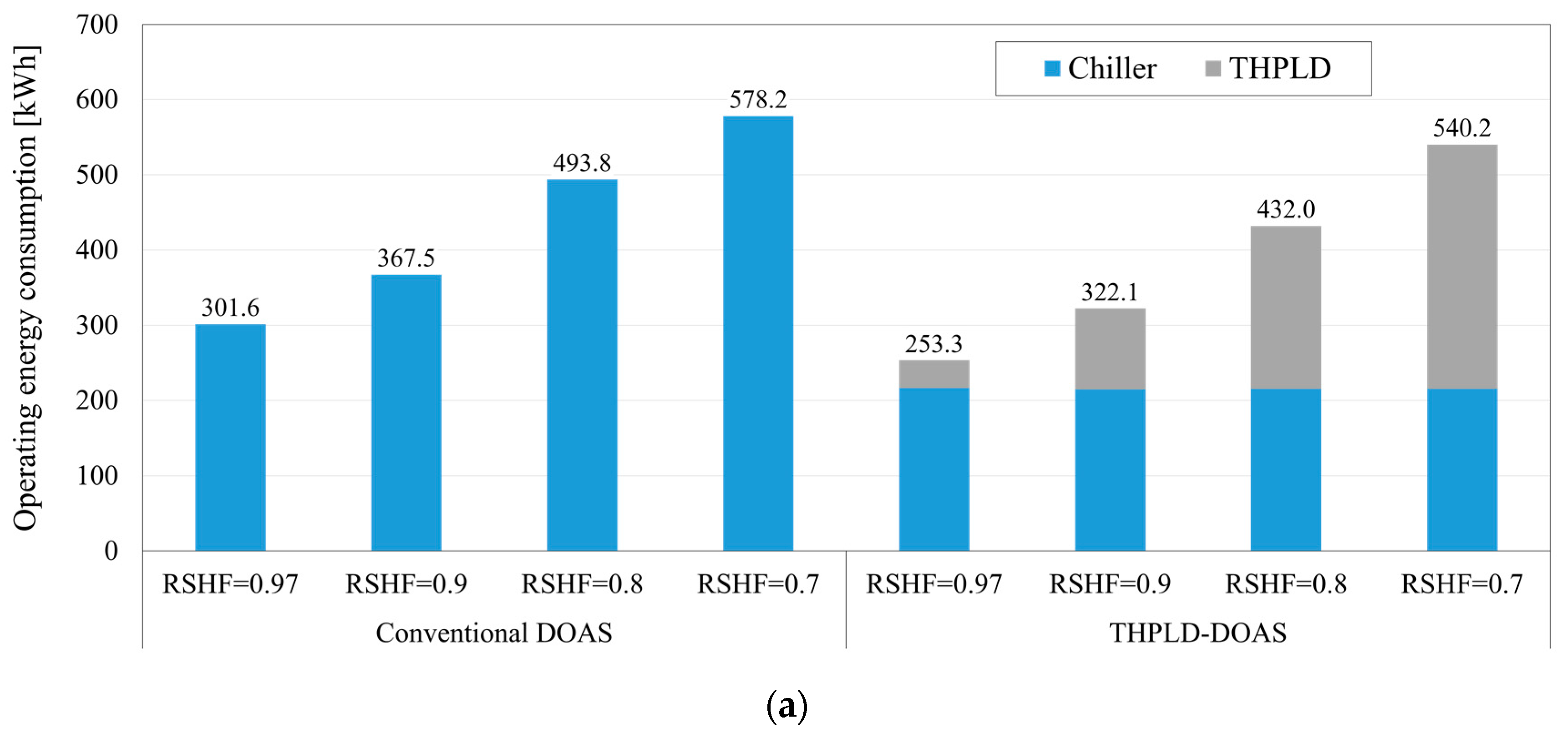
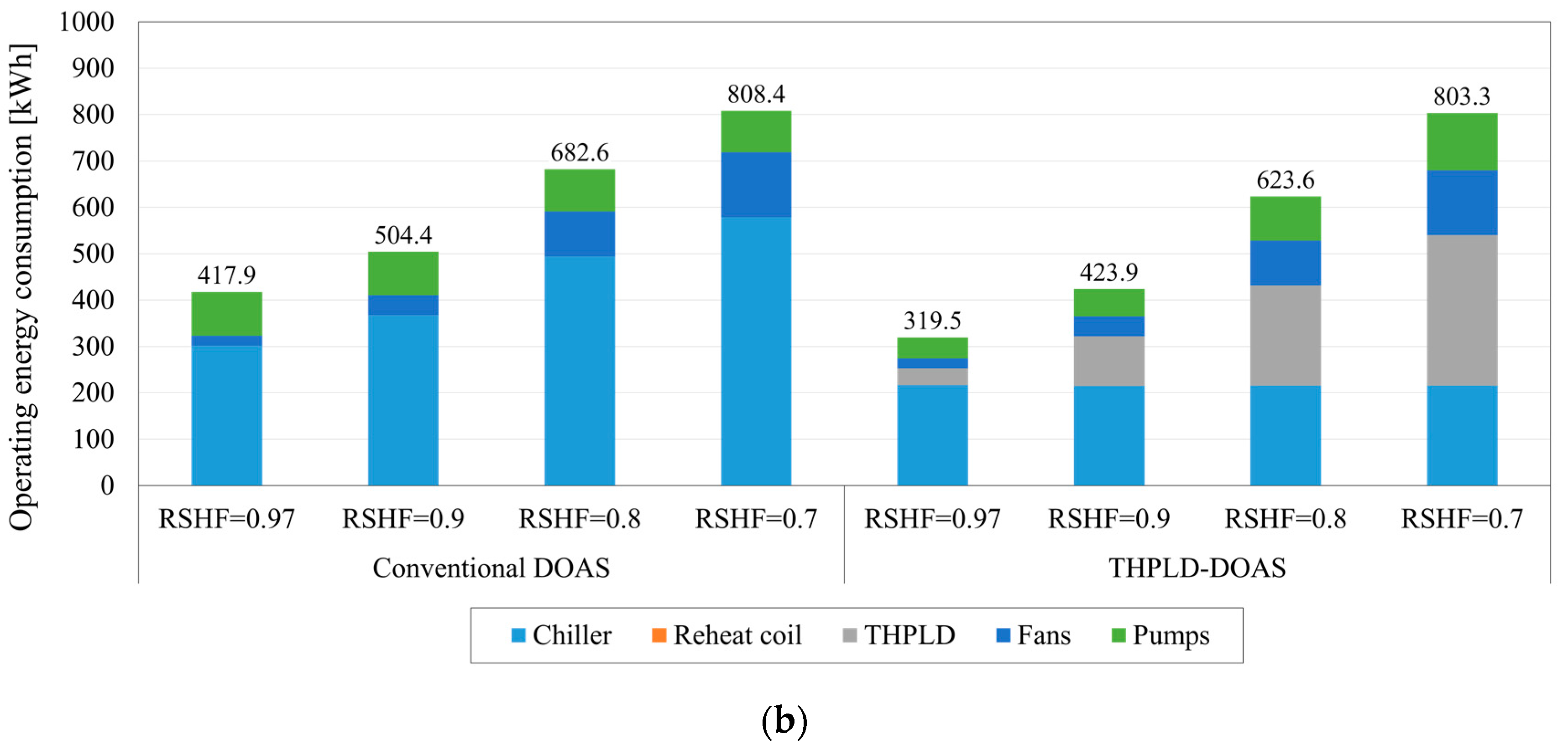
| Location | Seoul, Republic of Korea | ||||
|---|---|---|---|---|---|
| Floor area | Office area | 42 m2 | |||
| U-value | Exterior wall | 0.511 W/m2K | |||
| Roof | 0.316 W/m2K | ||||
| Window to wall ratio | 0.5 | ||||
| RSHF | 0.97 | 0.9 | 0.8 | 0.7 | |
| Ventilation rate | 84 m3/h | 168 m3/h | 378 m3/h | 546 m3/h | |
| Lighting density | 13 W/m2 | ||||
| Infiltration | 0.3 air changes per hour (ACH) | ||||
| Schedule | 07:00–22:00, five days a week | ||||
| Indoor air condition (Summer) | Dry-bulb temperature (DBT): 26 °C, Relative humidity (RH): 50% | ||||
| Peak sensible cooling load | 4.5 kW | ||||
| Peak latent cooling load | 0.2 kW | 0.5 kW | 1.1 kW | 1.9 kW | |
| Thermal Conductivity | |
| Electrical Resistivity | |
| Seebeck Coefficient |
| Curves | ||||||
|---|---|---|---|---|---|---|
| CAPFT | 0.958546443 | 0.035168695 | 0.000124662 | −0.00274551 | −0.00005000 | −0.00017234 |
| EIRFT | 0.732700123 | −0.00834360 | 0.000638530 | −0.00303753 | 0.000484952 | −0.00083584 |
| EIRFPLR | 0.070862846 | 0.002787560 | −0.00000891 | 0.230973399 | 1.250442176 | −0.00216102 |
| –66.40919 | –827.67671 | 38798.58774 | 0.33094 | –9.60442 | 16.76649 |
| 81.44688 | 13.52746 | 2.08691 | 60209.13462 | 0.68300 | 31.74440 |
| –36.53724 | –164.59549 | –2216.93209 | 2220.82332 | –0.023188 | 0.024267 |
| - | - | ||||
| 0.12427 | –0.67052 | –3.32718 | 6.69694 | - | - |
| Nomenclature | Component | Head Loss |
|---|---|---|
| Solution pumps for the absorber and regenerator | 0.4 m each at 1.1 m3/h | |
| Chilled water for the cooling coil | 0.3 m |
© 2017 by the authors. Licensee MDPI, Basel, Switzerland. This article is an open access article distributed under the terms and conditions of the Creative Commons Attribution (CC BY) license (http://creativecommons.org/licenses/by/4.0/).
Share and Cite
Kim, M.-H.; Park, J.-Y.; Jeong, J.-W. Energy Saving Potential of a Thermoelectric Heat Pump-Assisted Liquid Desiccant System in a Dedicated Outdoor Air System. Energies 2017, 10, 1306. https://doi.org/10.3390/en10091306
Kim M-H, Park J-Y, Jeong J-W. Energy Saving Potential of a Thermoelectric Heat Pump-Assisted Liquid Desiccant System in a Dedicated Outdoor Air System. Energies. 2017; 10(9):1306. https://doi.org/10.3390/en10091306
Chicago/Turabian StyleKim, Min-Hwi, Joon-Young Park, and Jae-Weon Jeong. 2017. "Energy Saving Potential of a Thermoelectric Heat Pump-Assisted Liquid Desiccant System in a Dedicated Outdoor Air System" Energies 10, no. 9: 1306. https://doi.org/10.3390/en10091306





